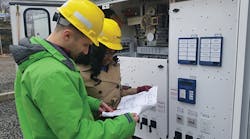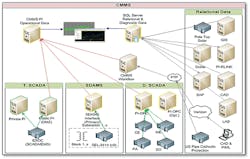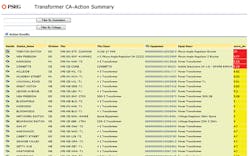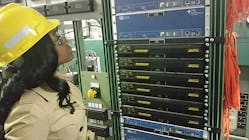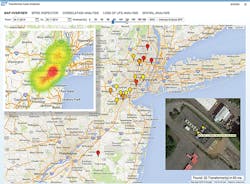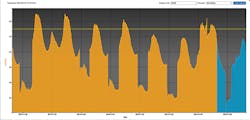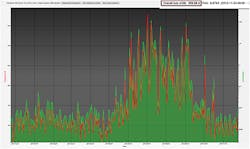Public Service Electric & Gas Co. (PSE&G) has always worked to provide reliable service to its 2.2 million electric and 1.8 million gas customers. In 2001, the utility’s electric delivery asset strategy department launched a project to create a computerized maintenance management system (CMMS) that would use a proactive, condition-based maintenance (CBM) approach to help predict equipment failures before they occurred.
For the past 13 years, PSE&G has seen tremendous value in the CBM program, which enables the utility to focus its efforts on performing the right maintenance at the right time.
Decision Support System
The CMMS is a decision-support system that assists in making repair, replacement and maintenance decisions for substation transformers, load tap changers (LTCs), breakers and circuit switchers, transmission overhead and underground assets, and 26-kV underground transformers and protectors. The CMMS has three main objectives:
- Enable the utility to perform the right maintenance at the right time, based on the consistent analysis of data to ensure a safe, reliable and cost-effective approach
- Centralize and correlate operational, diagnostic, maintenance, real-time sensor and nameplate/characteristics data down to the asset level
- Create condition-based and life-cycle algorithms that transform data into actionable information and use this data to drive business plans for asset replacement.
The CMMS platform consists of the PI System and software application modules from OSIsoft, a SQL server relational database, the SAP Plant Maintenance (PM) module, SAP HANA, Microsoft SharePoint 2013 and BusinessObjects XI reports. The system became operational in 2002. To date, it has allowed PSE&G to use CBM results along with the knowledge of subject-matter experts to predict potential failures. The system is estimated to have saved PSE&G more than US$50 million in maintenance and capital costs. The majority of these savings are attributed to failure avoidance on substation transformers and LTCs.
Building the Monitoring Platform
The strategy behind the CMMS is to collect and centralize data from multiple systems, transform that data into actionable information through CBM algorithms, save the results to a data warehouse, analyze the data and act on the information. The CMMS data architecture collects and centralizes real-time operational, real-time nonoperational, diagnostic, maintenance and equipment characteristic data.
The PI System collects data from the transmission supervisory control and data acquisition system (SCADA), the distribution SCADA, weekly substation inspections (using the PI Manual Logger and the substation data acquisition management system [SDAMS]). SDAMS is a nonoperational data path from a PI DNP interface node to remote terminal units (RTUs) and Schweitzer Engineering Laboratories (SEL) 2414 transformer monitoring devices in the substation, bypassing the SCADA systems.
RTUs concentrate pumping plant, gas-density monitoring and beacon-light data. The SQL server relational database collects data from the SAP PM module (substation assets), DeltaX, Doble and an in-house infrared database (diagnostic test results), geographic information system (assets outside of a substation) and computer-aided dispatch (inspection results). PSE&G uses the OSIsoft PI asset framework to group assets and correlate all data down to the asset.
Transformer Analytics
Using OSIsoft tools, PSE&G was able to build a CBM platform that looks at factors such as cooling performance, load performance, dissolved gas analysis tests and physical tests from comparative equipment, and rank the equipment according to the sum of the factors.
CBM is a proactive equipment maintenance capability that uses system health indications to identify and predict functional failure in advance of the event, and provide the ability to take appropriate preventive action. This approach to maintenance uses data extracted during operations and maintenance intervals to forecast the need for additional or future maintenance. It extends the concepts of predictive maintenance by using data from maintenance tests. Ideally, CBM will allow maintenance personnel to locate and resolve asset functionality issues before they escalate, thereby minimizing corrective maintenance costs and system downtime. CBM recognizes maintenance is both a technical and business process that must be managed for effective execution.
The CMMS provides the means for optimizing the maintenance of PSE&G’s assets through the use of condition-based tools. This system uses available information on equipment health by incorporating it into the maintenance decision process. Algorithms are set up to provide ranking systems for all transformers. The algorithm factors are based on the data available for each particular asset, and the factor weightings vary between voltage classes. PSE&G uses this available data to drive both condition-based action algorithms and replacement algorithms.
Data Determines Action
The action algorithms provide a score for each asset, with those most in need of review or action scoring the highest. Engineering meetings are held monthly to review and determine action. During the monthly review meetings, the asset engineers use the CMMS engineering desktop to review transformer CBM scores and investigate the data driving the scores to determine the next maintenance action.
Replacement algorithms are used to help identify equipment advancing toward completion of useful life. The algorithms are periodically reviewed and adjusted to keep them on track in identifying equipment maintenance needs.
PSE&G uses weighted algorithms to determine the health and replacement score for each transformer. The overall structure of the algorithm is simple:
Health/replacement score =
(Score of factor n × Weight of factor 1) +
(Score of factor 2 × Weight of factor 2) +
(Score of factor n × Weight of factor n).
Applying the right scoring and weights has been an evolutionary process. The algorithm results have taught PSE&G a lot about the performance of its transformers, and algorithms have been adjusted as a result of these findings.
Successful Program
PSE&G’s CBM program has been successful in the past 13 years at identifying problems and remediating issues before failures. It is a valuable system when the following statements are true:
- More than 4 billion assets are installed with a replacement value greater than $9.7 billion.
- The average age of assets exceeds 40 years.
- All equipment is expected to be used and useful all the time.
PSE&G has saved millions of dollars in equipment failure avoidance. For example, in 2009, during a monthly condition assessment review meeting, a 230-kV LTC had a score of 9, with 10 being the worst possible score. Immediately, the maintenance department was contacted. They communicated to the subject-matter experts that the operations group was running the LTC from +15 to -15 to regulate the voltage to the nuclear plant. The subject-matter experts stopped this and ordered an immediate inspection of the LTC. Results showed half of the contacts were deteriorated. It was later determined if this issue had not been discovered during the CBM review, the LTC most likely would have failed, which would have caused the transformer to trip. This action saved an estimated $3.8 million by avoiding this potential failure.
A second example occurred in 2011. During another monthly condition assessment review meeting, a 13-kV LTC was showing a score of 8.4, which was the worst score of all the LTCs. At that time, the PSE&G delivery construction group was replacing a second transformer within the substation. The entire load was swapped over to single transformer, which caused the LTC in question to show the worst condition score. An immediate inspection of the tank revealed excessive gassing and overheating as a result of contact coking (carbon buildup). The proper repair was performed prior to replacement of the second transformer. This was a tremendous find, as the LTC contacts would have failed if any additional station load had been added during replacement of the second transformer.
PSE&G has no secret sauce for its success. The utility attributes the success of its CBM program to its asset engineers and their commitment to the program as well as to the data owners for ensuring data integrity. To be successful in an effort like this, it requires a significant culture change and commitment to regularly reviewing the data and keeping it accurate.
Advanced Analytics
Power transformer equipment designed and manufactured to utility specifications generally is considered to have a high degree of reliability and relatively low failure rates. Variability in the operating conditions and maintenance practices for transformer equipment, as well as the low rate of failure, make it difficult to define a universal average life accurately. However, industry information presented during an IEEE Transformers Committee Tutorial in 2007 indicates a tendency for low failure rates until about age 25, moderately increasing failure rates through about age 35 and more rapidly increasing failure rates beyond age 35.
During normal transformer operation, dielectric integrity deteriorates over time as a result of thermal aging of insulation. Moisture introduction through leaks and fault activity outside the transformer can accelerate this deterioration, thus increasing the probability of failure. Deterioration can be slowed and transformer life extended through condition assessment monitoring and response with appropriate and cost-effective CBM, as practiced by PSE&G.
As degradation progresses, the cost of maintenance will increase and the effectiveness of repeated maintenance will diminish, resulting in a detrimental impact on transformer and system reliability. Despite traditional maintenance efforts, replacement will become necessary to maintain system integrity and reliability.
PSE&G’s transformer life-cycle replacement program, which was formulated in 2008 for transmission-class transformers, is designed to maintain system reliability through appropriate replacement of equipment. The selection of replacement candidates is based on an engineering review of transformer condition scores, physical condition, chronological age, spare availability, and the impact on customers and systems in the event of failure. The selection process also passes over replacements already planned because of project upgrade needs.
True Age
Over the last few years PSE&G started using the transformer monitoring program (TMP) real-time sensor data from its SDAMS interface to better determine the true age of a transformer. The utility worked closely with the SAP HANA team to implement the IEEE C57.91-2011 equations to determine the transformer (insulation) aging acceleration factor and loss of life for specified periods of time.
The SDAMS interface pulls the following data points from 126 transformers every minute:
- Top oil temperature
- Winding/hot spot temperature
- Ambient temperature
- Transformer load
- Transformer volts
- Cooling hours and load of fans
- Calculated top oil temperature
- Calculated winding temperature
- LTC tank temperature.
Currently, the real-time sensor data is manually sent to HANA for analysis. In 2015, PSE&G is working with OSIsoft and SAP to implement the PI Integrator for SAP HANA, to automate the streaming of data from PI to HANA.
Double-clicking a pin on the geographical overview screen allows PSE&G engineers and planners to investigate individual load curves easily. The curves can be plotted against the transformer normal or emergency ratings, and the user has the ability to conduct forecasting of the next day’s load, represented as the blue line in the graph. place graphic here.
The more sophisticated IEEE loss-of-life calculation provides the number of days a transformer has aged based on the heat run properties of the transformer, the continuous load, the top oil temperature, the ambient temperature and the winding/hot spot temperature for a selected time frame. In one case, data showed a 230/13-kV transformer aging only 209 days within one year. This information will be extremely valuable to the utility’s engineers, enabling them to decide to keep the transformer in service past its expected life cycle.
Other transformers show aging more than 365 days within one year. In the graph, Place graphic here the green line represents the transformer loss of life while the red line represents the winding/hot spot temperature over top oil temperature. This information is written back to the CMMS to help drive the transformer replacement algorithm and will be valuable when identifying the correct assets for replacement.
Other analytics provided on the HANA platform include correlating different sensor readings, identifying bad data (outliers) and integrating other data sources such as maintenance costs and critical customers.
The benefits of the transformer advanced analytics are identifying the true age of a transformer through the IEEE C57.91-2011 loss-of-life calculations and including the information within the transformer replacement algorithm. In addition, it gives engineers and planners easy access to transformer load and loss-of-life profiles, provides the ability to forecast data into the future and, lastly, has the capability to integrate with other data sources.
All new transformers will have the TMP devices and sensors installed. PSE&G has decided, for financial reasons, not to retrofit its older transformers with TMP. The utility is building a system for the next generation of engineers by giving them the ability to see detailed performance of their substation transformers and determining the true age of transformers through the loss-of-life calculations.
Proactive Maintenance
CMMS implementation has enabled PSE&G to shift maintenance activities from reactive to proactive by using condition monitoring, trend evaluation and expert system diagnosis. As a result, PSE&G has reduced catastrophic failures, increased equipment availability and reduced maintenance costs. Employees are able to estimate failures of transformers and other devices, and can start projecting the most cost-effective replacement program for these devices. The age of a device is only a small factor when considering replacement, whereas, prior to the CBM program, age was the only driver.
Richard Wernsing ([email protected]) is manager of electric asset strategy at Public Service Electric & Gas Co. His responsibilities include the definition of asset information strategies for the utility, asset risk management, future systems evolution, successful deployment and implementation technologies, and providing technical expertise for mobile business development projects. His 50-plus-year career has been in the delivery, transmission and production of electricity as well as computer and telecommunications support.
Angela Rothweiler ([email protected]) is a reliability centered maintenance expert at Public Service Electric & Gas Co. within the electric asset strategy group. Her responsibilities include maintaining and enhancing the computerized maintenance manager system. She has been with the utility for 12 years and focuses on data integration and condition-based maintenance programs. She has a master’s degree in software engineering.
